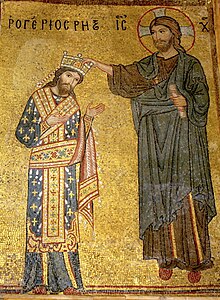Roger II of Sicily
| Roger II | |
|---|---|

|
|
| King of Sicily | |
| Reign | 27 September 1130 – 26 February 1154 |
| Coronation | 25 December 1130 |
| Successor | William I |
| Born |
22 December 1095 Mileto, Calabria |
| Died | 26 February 1154 (aged 58) Palermo, Sicily |
| Burial | Cathedral of Palermo, Sicily |
| Spouse |
Elvira of Castile Sibylla of Burgundy Beatrice of Rethel |
| Issue |
Roger III, Duke of Apulia Tancred, Prince of Bari Alfonso of Capua William I of Sicily Constance, Queen of Sicily Simon, Prince of Taranto |
| House | Hauteville |
| Father | Roger I of Sicily |
| Mother | Adelaide del Vasto |
Roger II (Sicilian: Ruggeru II di Sicilia; 22 December 1095 – 26 February 1154) was King of Sicily, son of Roger I of Sicily and successor to his brother Simon. He began his rule as Count of Sicily in 1105, became Duke of Apulia and Calabria in 1127, and then King of Sicily in 1130. By the time of his death at the age of 58, Roger had succeeded in uniting all the Norman conquests in Italy into one kingdom with a strong centralized government.
By 999, Norman adventurers had arrived in southern Italy. By 1016, they were involved in the complex local politics where Lombards were fighting against the Byzantine Empire. As mercenaries they fought the enemies of the Italian city-states sometimes fighting for the Byzantines and sometimes against them, but in the following century they gradually became the rulers of the major polities south of Rome.
Roger I ruled the County of Sicily at the time of the birth of his youngest son, Roger, at Mileto, Calabria, in 1095. Roger I's nephew, Roger Borsa, was the Duke of Apulia and Calabria, and his great nephew, Richard II of Capua, was the Prince of Capua. Alongside these three major rulers were a large number of minor counts, who effectively exercised sovereign power in their own localities. These counts at least nominally owed allegiance to one of these three Norman rulers, but such allegiance was usually weak and often ignored.
...
Wikipedia
